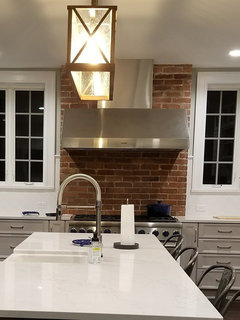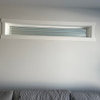Range Hood Size
Hi I have a 30in. cooktop that has a builder grade hood that is installed under a cabinet. I will be getting a custom hood and I wanted to go with a 36in. but the cabinet guy says that it is standard to go with 30 in hood when you have a 30in cooktop. Would it look weird if I go with 36in? I want it to make a statement and I don't think it will at 30 in.. Thoughts????
Comentarios (17)
Sterl Kitchens Co. Inc.
hace 6 años30 over 30 is how 99% of people do it so I can't disagree with your pro. Now for the 1% that have their hoods custom built, my custom hood guy does recommnd a 6" wider hood to help capture the fumes.simstress
hace 6 añosIt will not look weird to go wider. If you have the funds and space, get the 36.jessi6263
Autor originalhace 6 añosThank you for your suggestions. I want the kitchen to look more custom and it sounds like going with 36 would make it look more custom .friedajune
hace 6 añosÚltima modificación: hace 6 años"for the 1% that have their hoods custom built,.."
Disagree. Having a hood that is 6" wider than the cooktop is not just for custom-built hoods. Sterl Kitchens Co, - you are out of step, not current. Anyone with the most basic kitchen that there is can, and will, buy a 36" hood for a 30" cooktop. Especially with today's cooktops which even at lower price tiers have a lot of btus (as compared to 10 years ago). Go to Costco's site, and you will see some good quality hoods, at good prices, in the 36" size, and that size tends to sell out on the Costco website.
Michael Lamb
hace 6 añosIf you have a 36" wide induction cooktop, what width hood do you get? Does not seem to be many options in the 42" width...
Patricia Colwell Consulting
hace 6 añosI am more concerned with CFM than the hood width I have always had a hood the same size as my gas range but with a bit more oomph than the average and never had a problem with not capturing the heat and the steam.
lapsangtea
hace 6 añosDo what you want. Get pictures/mock up what your materials will look like in your kitchen. Absolutely not weird to go bigger. I've seen kitchens look great both ways. This will solve the aesthetic issue.
Functionally, usually bigger than cooktop is preferred, but many manage well enough with same size. Look at cooking style, hood capabilities. Don't let it drive you too crazy....
DrB477
hace 6 añosÚltima modificación: hace 6 añosI mean realistically most people use the same size. Or no hood at all. Or a non vented recirculating one. Or a microwave hood that really only covers the back two burners... you get the idea.
But while its certainly not a disaster to have a same sized hood, if you are going to do ventilation right, you are better off with 6" wider hood. It doesn't look weird. Here's my 54" hood over 48" range.

Anglophilia
hace 6 añosAny good pro will tell you that your hood needs to be 6" wider than your stove. CFM should also be 600. If someone is telling you otherwise, they must install schlock.
Patricia Colwell Consulting
hace 6 añosThanks for that comment, I have been designing kitchens for 30 + years and have very often done as i mentioned with no problems ever and IMHO 600CFM is the bare minimum for good venting of a high BTU gas range.
Main Line Kitchen Design
hace 6 añosThere is no question that if you have the room all hoods look and work better when they are wider than the cooktop or range below. Most kitchen designers don't do this only because they don't know any better. And it is building code in the United States that any hood over 400 CFM's needs a replacement air system. So be careful using more powerful hoods without replacement air. Carbon monoxide pulled back into your home from your furnace or water heater by a powerful hood can be deadly..
There is also little debate among the top kitchen design professionals that the recommended clearance above the cooktop from appliance companies is low and that their recomended projections (front to back) of hoods is too deep for residential applications. Residential kitchens do not use professional appliances the same way restaurants do and looks matter inside someones home as opposed to the back of a busy restaurant.
simstress
hace 6 añosFrom what I read, the MUA requirement depends on hood CFM as well as sqft of the home. A really spacious home could use a relatively more powerful fan before hitting MUA. Local codes may differ too. Though 400 CFM may be a useful guideline because it balances with sqft of many homes... just my conjecture!DrB477
hace 6 añosÚltima modificación: hace 6 añosIf I understand correctly, international residence code (IRC), which is the standard most US localities follow, mandates MUA at 400 cfm. Whether your home REALLY needs it is a function of sq footage and how drafty the home is. But for most people, code will mandate MUA at 400 cfm.
jhmarie
hace 6 añosActually, according to Fred, our expert on codes, there is no code requirement to have a hood. However, if you do and it is over 400cfm, make up air becomes a requirement.
The cfm requirement is usually based on the range / stovetop. I have a very ordinary 30" range (Maytag from Lowe's) and my 390 hood is more than sufficient. While I cook dinner every night, I am not a pro cook or a caterer like patricia and rarely have more than 2 burners going and often do not use the stovetop at all.
Many people are installing pro type ranges in their new homes and these will do best with significant venting if actually used for frequent cooking.
Main Line Kitchen Design
hace 6 añosÚltima modificación: hace 6 añosYes. Any hood anywhere in the United States requires a make up air system if it is over 400 CFM's The size of the home is less important than how well it is sealed in determining how dangerous breaking the rule would be. In our area homes built in the 90's were so air tight that even 400 CFM's is probably dangerous.
There is no requirement to even have a hood or to adhere to what the range manufacturer recommends for a particular range. Recommendations for professional appliances are based on commercial use and are overkill in a residential setting. But if you have a hood it can't be over 400 CFM's without a replacement air system.

Volver a cargar la página para no volver a ver este anuncio en concreto



jhmarie